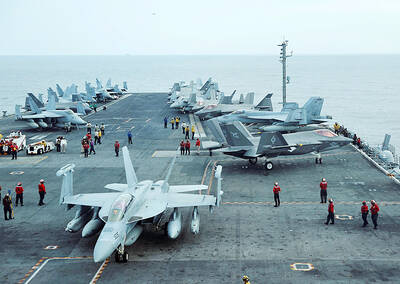As regional tensions continue to grow over overlapping claims in the South and East China Seas, China’s premier civilian maritime agency announced last week it would commission more than three dozen new vessels by next year.
Quoting Chinese government officials, the state-affiliated China Daily reported that to safeguard China’s huge maritime interests, the China Marine Surveillance (CMS) would add 36 ships to its fleet by next year. An unnamed CMS official said that seven vessels would have a displacement of 1,500 tonnes, 15 of 1,000 tonnes and 14 of 600 tonnes.
Construction of the 600-tonne cutters reportedly began on Tuesday in Weihai, Shandong Province.
The vessels will be distributed to 14 provinces, autonomous regions and cities along the Chinese coastline, it said.
Last week’s announcement seemed to indicate that the CMS was accelerating its acquisition of new vessels amid disputes with the Philippines, Vietnam and Japan. CMS Deputy Director Sun Shuxian (孫書賢) said in May last year that the 36 new ships would be acquired over the next five years as part of the 12th Five Year Plan approved by the State Council. Under the plan, the agency would also increase personnel by more than 1,000, to about 10,000, and China would “carry out regular sea patrols more frequently to strengthen law enforcement in Chinese-related waters to safeguard the country’s maritime rights in 2011.”
At the time of Sun’s announcement, the CMS counted a fleet of as many as 300 marine surveillance ships — including 30 with displacement of more than 1,000 tonnes — as well as six fixed-wing aircraft and four helicopters.
Jane’s Defence Weekly reported last year that a growing number of larger CMS vessels were capable of carrying helicopters and were becoming more advanced in terms of electronics and maneuverability.
CMS ships were recently involved in China’s dispute with the Philippines over the Scarborough Shoal (黃岩島) and are also used to enforce China’s claims to the Spratly (南沙群島) and Paracel islands (西沙群島) in the South China Sea, of which Taiwan is also a claimant. CMS patrol ships sailing close to the Diaoyutai Islands (釣魚台) have also sparked disputes with Japan.

A year-long renovation of Taipei’s Bangka Park (艋舺公園) began yesterday, as city workers fenced off the site and cleared out belongings left by homeless residents who had been living there. Despite protests from displaced residents, a city official defended the government’s relocation efforts, saying transitional housing has been offered. The renovation of the park in Taipei’s Wanhua District (萬華), near Longshan Temple (龍山寺), began at 9am yesterday, as about 20 homeless people packed their belongings and left after being asked to move by city personnel. Among them was a 90-year-old woman surnamed Wang (王), who last week said that she had no plans

TO BE APPEALED: The environment ministry said coal reduction goals had to be reached within two months, which was against the principle of legitimate expectation The Taipei High Administrative Court on Thursday ruled in favor of the Taichung Environmental Protection Bureau in its administrative litigation against the Ministry of Environment for the rescission of a NT$18 million fine (US$609,570) imposed by the bureau on the Taichung Power Plant in 2019 for alleged excess coal power generation. The bureau in November 2019 revised what it said was a “slip of the pen” in the text of the operating permit granted to the plant — which is run by Taiwan Power Co (Taipower) — in October 2017. The permit originally read: “reduce coal use by 40 percent from Jan.

China might accelerate its strategic actions toward Taiwan, the South China Sea and across the first island chain, after the US officially entered a military conflict with Iran, as Beijing would perceive Washington as incapable of fighting a two-front war, a military expert said yesterday. The US’ ongoing conflict with Iran is not merely an act of retaliation or a “delaying tactic,” but a strategic military campaign aimed at dismantling Tehran’s nuclear capabilities and reshaping the regional order in the Middle East, said National Defense University distinguished adjunct lecturer Holmes Liao (廖宏祥), former McDonnell Douglas Aerospace representative in Taiwan. If

‘SPEY’ REACTION: Beijing said its Eastern Theater Command ‘organized troops to monitor and guard the entire process’ of a Taiwan Strait transit China sent 74 warplanes toward Taiwan between late Thursday and early yesterday, 61 of which crossed the median line in the Taiwan Strait. It was not clear why so many planes were scrambled, said the Ministry of National Defense, which tabulated the flights. The aircraft were sent in two separate tranches, the ministry said. The Ministry of Foreign Affairs on Thursday “confirmed and welcomed” a transit by the British Royal Navy’s HMS Spey, a River-class offshore patrol vessel, through the Taiwan Strait a day earlier. The ship’s transit “once again [reaffirmed the Strait’s] status as international waters,” the foreign ministry said. “Such transits by